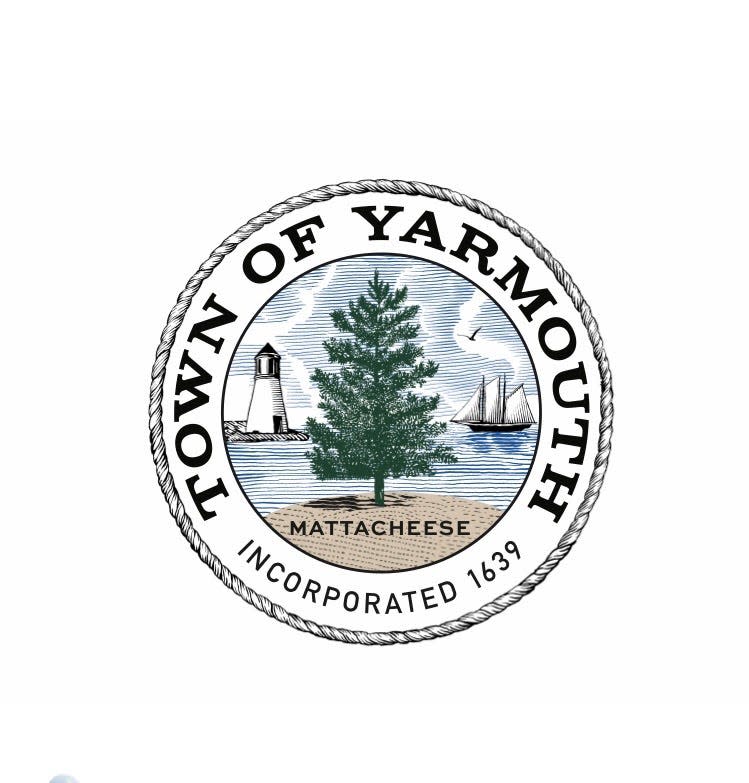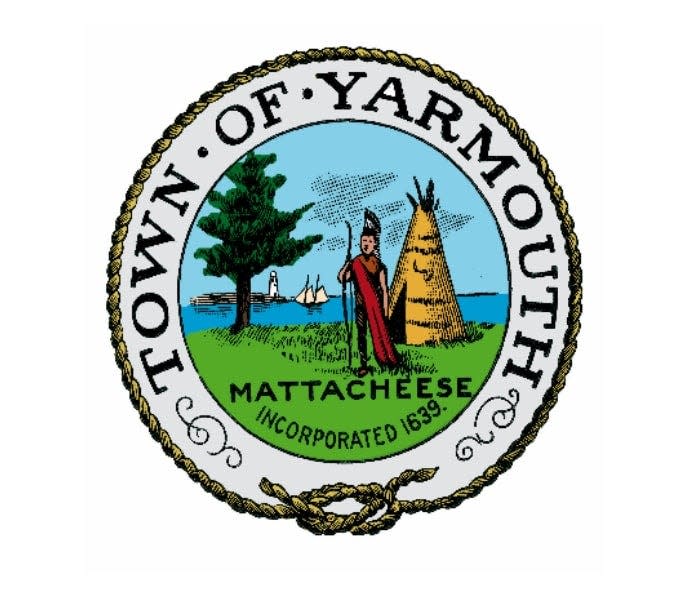Yarmouth unveils a new town seal, sparking debate around Native American imagery
Fritz Klaetke, a member of the Yarmouth Town Seal Review Committee, gently pulled back a white covering to reveal a proposed new town seal during Tuesday's Board of Selectmen meeting. The draft image shows an eastern white pine tree growing from sandy soil in the foreground of the seal, which is outlined in nautical rope. To the left is Point Gammon Lighthouse, and to the right is a two-masted schooner meant to emulate the David K. Akin ship that once traveled from Bass River to New York.
The seal's background is filled with sky and sea, drawn with a texture that mimics the striations of a quahog shell, said Klaetke during the meeting. Underneath the image, is the word: Mattacheese, which means "big or great sky" in Wôpanâak, the original language of Wampanoag people, said George Slama, vice chair of the Historical Commission. The draft is the first since the original seal was created in February 1895, said Bob Lawton, chair of the Seal Review Committee.

"This has been a 130-year journey," said Slama, who also sits on the Seal Review Committee. Yarmouth first began discussing alterations to its town seal in July 2021. Many communities across the state are making changes to town seals that incorrectly depict Native culture - including the town of Mashpee. In November 2021, the town debuted a new seal that focused on the Mashpee River and natural elements of the area that connect to the Mashpee Wampanoag Tribe. Discussions to change the town seal in Bourne were also proposed by community members in November 2022. A Special Commission on Official Seal and Motto of the Commonwealth was also established in July 2021, to rethink the Massachusetts state seal.
In Yarmouth, Slama said the public will have an opportunity to weight in on the new design, and eventually vote on a final seal during an annual town meeting.
What did the original seal look like?

The original seal depicts a Native American person, who is holding a bow and arrow, standing in front of a teepee. Ocean, boats, a tree and a lighthouse can also be seen in the background. Traditionally, said Slama, Wampanoag people had a different style of dress than what's shown on the original seal. Flawed elements, said Slama, also include the oversized bow and a teepee. Wampanoag people lived in summer and winter homes called wetus, he said.
In 2021, selectmen, in consultation with the Historical Commission, decided that the current town seal contained culturally inaccurate Native American imagery and during the April 2022 annual town meeting, residents voted to create the Seal Review Committee.
Selectmen buzz over the removal of Native person from seal
For Selectman Mark Forest, the first thing that jumped out at him when he saw the new seal, was the absence of the Native American.
Slama explained that the Committee decided to remove the Native person from the new design after reviewing meeting minutes from the Special Commission on Official Seal and Motto of the Commonwealth. In the minutes, Brian Weeden, chairman of the Mashpee Wampanoag Tribe, said that adding a person to a seal can be difficult, because one person isn't representative of every person in a community.
"It says a lot that Brian Weeden felt that having a human representative (in a seal) is problematic," said Slama.
Selectmen Chair Michael Stone said he understands the historical flaws within the original design, but was troubled that a Native person was replaced with a pine tree.
"How does (the pine tree) more accurately reflect the history of Indigenous people?" said Stone during the selectmen meeting.
Slama said eastern white pine trees were mentioned in Wampanoag creation stories. Through consultations with the Wampanoag tribe, the committee learned that Wampanoag people believe they were created from the roots of the white pine. Slama specifically pointed to an art exhibit which featured a wampum belt that centered the eastern pine tree in its design. The belt, which was created cohesively by Wampanoag tribal members, was included in a series of art exhibits facilitated by Paula Peters, a member of the Mashpee Wampanoag Tribe.
It will take time to educate people on aspects of the seal, said Slama.
"And that’s a fun part of this process," he said. "Our Native neighbors have a culture and it’s good to understand that and learn about it."Through a survey, which was sent to roughly 18,000 town residents, the committee found that 51% of residents wanted to modify the original seal. Out of the 3,000 survey responses, the majority of residents also said they wanted cultural imagery for Native people to be correctly implemented.
Many different town seals in Yarmouth
During the committee's research, the group also discovered that there are many variations of the town seal that are currently used by municipal departments including the fire department, the police department, and the Natural Resources department.
"We've been a little footloose and fancy," said Slama.
The official town seal isn’t supposed to be reproduced without permission of the town clerk and shouldn't be used for commercial purposes, said Town Clerk Mary Maslowski at the meeting.
Forest proposed that once a final design is brought to the town's annual meeting, a recommendation should be proposed that all seal variations "should be in sync" he said.
Committee members also crunched numbers associated with the cost of changing the seal. The change would need to be made on town uniform patches; collar pins and detail caps, as well as on municipal vehicles and signs throughout Yarmouth. If every seal is changed throughout town, said Lawton, the cost would be roughly $145,000. "If this goes forward and is put on the warrant, our job is to talk to town administration and the finance department to finetune costs," said Lawton.
Uncomfortable conversations need to be had, Ferretti said
Melissa Ferretti, chairwoman of the Herring Pond Wampanoag Tribe and a Bourne Select Board member, said Yarmouth's efforts are a move in the right direction. In Bourne, she said, the process to change the seal has "moved a lot slower than I envisioned." While the Bourne Historical Commission asked the Herring Pond Wampanoag Tribe to consult with them about a new seal, she said there hasn't been a ton of movement.
Ferretti served on the Official Seal and Motto of the Commonwealth committee. Many discussions held by the committee revolved around the way Native people are portrayed on seals across the country, and flawed cultural aspects.
"Our job was to make recommendations as to what we thought should happen and one of the recommendations was to establish curriculum development that would support the initiative," said Ferretti.
Public participation is also key, said Ferretti. Uncomfortable conversations need to be had, she said.
The state committee was disbanded in November. "We don't want to create division and arguing," said Ferretti. "But there is serious education that needs to happen."
Rachael Devaney writes about community and culture. Reach her at rdevaney@capecodonline.com. Follow her on Twitter: @RachaelDevaney.
Thanks to our subscribers, who help make this coverage possible. If you are not a subscriber, please consider supporting quality local journalism with a Cape Cod Times subscription. Here are our subscription plans.
This article originally appeared on Cape Cod Times: Yarmouth town seal: Why new design replaced Native person with a tree

